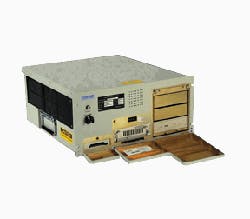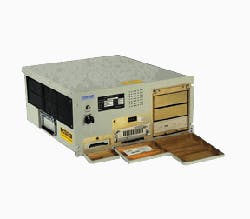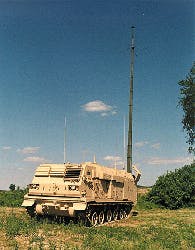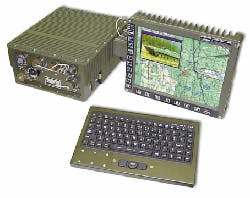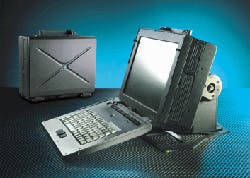Rugged COTS computers embracing CompactPCI
Rugged COTS computers embracing CompactPCI
The rugged classification for military computers, once heading quickly away from mil-spec classifications to embrace commercial technology, has started inching back toward military specifications, while designers of rugged computers are starting to push away from the VME architecture toward CompactPCI
By John McHale
Since the U.S. Defense Department`s commercial-off-the-shelf (COTS) initiative took hold six years ago, program mangers have been changing their environmental specifications and moved away from mil-spec requirements to embrace low-price, state-of-the-art commercial technology.
Now older and wiser, military program managers and systems designers have decided to retain some of the military-standards of the past, and at the same time are turning toward the CompactPCI printed circuit card form factor for compatibility with the popular Intel microprocessors and Microsoft Windows operating system.
Many military programs such as the U.S. Air Force Airborne Warning and Control System — better known as AWACS — have embraced COTS and have relaxed their environmental constraints to adopt new commercial technology. Still, some industry experts see the rush to COTS slowing down.
There is a lot of discussion in the COTS world these days about what is acceptably rugged, explains Maury Koelemay, manager of strategic marketing at DRS Rugged Systems in Longmont, Colo. Designers, in fact, are starting to rethink their commitments to some COTS components, he says.
The reason for this change of heart revolves around reliability problems that some designers have experienced with COTS. More to the point, some rugged industrial-temperature devices that military systems designers have been used in the recent past are not hacking it. "The pendulum is swinging back toward the direction of mil-spec," Koelemay claims.
The 425M-S Ultra 2 rugged workstation from DRS Rugged Systems is riding on the U.S. Army M4 Command and Control Vehicle — better known as the C2V, from the United Defense LP Ground Systems Division in York, Pa. The DRS 425M-S also is part of the U.S. Army Common Hardware Software-2 battlefield computer program, also known as CHS-2. The rugged device has a 100 megabytes per second Ethernet card and a 20 megabytes per second, 16-bit SCSI-2 interface.
The prime on CHS-2 is General Dynamics Communications Systems in Taunton, Mass., with Sun Microsystems in Palo Alto, Calif. Both companies are providing the workstations and servers.
The program provides common hardware, peripherals, and software for the Army Battlefield Command Systems Battlefield Functional Area Control Systems, which automate control of the five fundamental components of land warfare — maneuver, fire support, combat service support (logistics and medical services), intelligence/electronic warfare, and air defense.
General Dynamics has basically two types of ruggedization, depending on the severity of the environment at hand, says Chris Marzilli, vice president and general manager of commercial hardware systems at General Dynamics Communications Systems (formerly GTE Government Systems).
Army officials have established the "V2 specification" for tactical operations centers where combat leaders plan and collaborate on missions. Marzilli says this specification calls for 0 to 120 degrees Fahrenheit operating temperatures, -25 to 150 F for storage, humidity at 10 to 95 percent in mist and fog, operation on the move in wheeled and tracked vehicles (but not tanks), spillage (but not blowing rain or high pressure hose down), and resistance to electromagnetic interference (EMI) and electromagnetic pulse (EMP). It is shelter and tent rugged, Marzilli adds.
"V2 strikes a cost-conscious pose between pure COTS and traditional mud box" or V3, Marzilli says. The V3 classification, meanwhile, is for more harsh environments than V2 that involve mission-critical applications, Marzilli continues.
Today`s rugged specifications are drifting back toward mil-spec, says Jeff Palombo, vice president of business development at Miltope Corp. in Hope Hull, Ala.
The only holdouts are magnesium-cased laptop or hand-held devices, for which designers use commercial technology and give up environmental constraints to embrace the low-cost commercial technology, he explains. Large companies sell these computers at two-thirds the cost of most mil-spec computers, Palombo says. Airmen or soldiers will take these same computers from the depot to the aircraft and back, but not outside in the field, Palombo adds.
Many customers ask for rugged computer because the do not need the expensive documentation that goes with a mil-spec computer, says Chris Chance, manager of business development for vetronic systems at Computing Devices Canada in Nepean, Ontario. However, some customers still ask manufacturers to test rugged computers to MIL-STD 810e and 461, Chance adds.
The soldiers will still want to kick it and still treat it the same way as any mil-spec device, so it needs to be durable, Chance says.
Miltope designers lean toward the militarized side of rugged, Palombo says. "We still push toward MIL-STD 461 for electromagnetic interference and have sealed hard drives," he adds. However, "there are still some people out there who take a commercial box, paint it green, and call it rugged," Palombo adds. Buyers beware, he warns.
The level of rugged depends on the specific application, says Ken Pine, director of marketing at Dolch Computer Systems in Fremont, Calif. Rugged is based on what shock and vibration and environmental requirements a customer may need, he says.
Dolch can go from industrial-grade (10 Gs of shock and vibration) to military-grade (30 Gs of shock and vibration) on their systems, Pine says. Dolch maintains an in-house environmental test facility, including a shake table and programmable shock-and-vibration test system, which Pine claims is fairly rare in commercial computer companies.
Dolch engineers offer the TransPAC (Transportation Portable Add-in Computer) for jarring transportation service on ships, trains, trucks, and military cargo airplanes. It has been qualified to MIL-STD-810E for shock loads of 40 Gs and random vibration of nearly 6Gs rms. It has been tested for operation to -40 degrees C and certified to meet the EMI/RFI emission requirements of MIL-STD-461.
Optional features of the TransPAC include an expansion module with four add-in slots, a host of industry standard I/O modules, and an environmental control system for operation in extreme temperatures. The size of an ordinary notebook computer, it can operate from AC power or from an internal battery. Although designed to meet stringent military specifications, it is a COTS computer, Pine says, because it meets commercial and industrial prices that are significantly less than most mil-spec hardware.
Rugged computers are also becoming smaller and lighter, Marzilli says. "This is largely being accomplished by replacing cathode ray tube displays with liquid-crystal, flat-panel displays, embedding UPS with more modern battery technologies such as Lithium Ion, and taking advantage of notebook targeted mass-storage devices such as 2.5 inch disks," Marzilli explains.
The General Dynamics Versatile Computer Unit (VCU) has these features and has become standard for the Army Battle Command System, Marzilli claims. The VCU accommodates Dual Pentium III motherboard or Sun AXi motherboard, 6 PCI slots, AC/DC power input with built-in UPS, display and keyboard remotable (virtual laptop), touch/voice/infrared alternatives to keyboard, takes SCSI and EIDE mass storage, and weighs less than 50 pounds.
CompactPCI
"We are seeing a push for CompactPCI, which enables the operator to have more ability to hot-swap field replaceable units," Marzilli says. "With this comes modular power supplies, fan trays, and the ability to service at the unit level. Commercial telecommunications companies are driving the market for CompactPCI, but the U.S. Department of Defense will benefit from the inherent ruggedness, small form factor, and modularity.
"VME is too boutiquey," he says. In other words major computer manufacturers such as Sun Microsystems or IBM in Armonk, N.Y., do not make VME, but they do produce CompactPCI machines, Marzilli points out.
If one wants a command-and-control system based on Intel technology, CompactPCI is the best choice because it translates well to Intel products, Chance says. When using VMEbus, extra drivers need to be written to perform the same functions, he says.
Using CompactPCI also forces designers to deal with rapid turnover of commercial technology and technology-insertion schemes to deal with the obsolescence, DRS`s Koelemay says. Still, when going with technology insertion they are going with a standard form factor such as CompactPCI so they can easily insert a Pentium II or III to replace a Pentium, Koelemay explains.
Marzilli says he also sees CompactPCI proliferating ever more widely into embedded subsystems. "As the need for situational awareness increases on the battlefield we are seeing a proliferation of purpose-built computers being driven down into the weapons platforms," he says. For The Force 21 Battle Command, Brigade and Below program, also known as FBCB2, prime contractor TRW specifies a CompactPCI form factor with a Pentium II processor, Chance says.
For these applications the "ruggedization required is more involved to meet the wider temperature range, high pressure hosedown, explosive atmosphere, salt fog, and severe vibration curves for operations on the move," Marzilli says.
Scalability is another growing trend in rugged computing, Marzilli says. "With the onset of more client-server computing, we are called upon to deliver more powerful and extensible processing engines, he explains.
"Our latest high-end server, [the V2 Axmp] is based on Sun`s new Axmp, a 4-way multi-processing UltraSPARC II architecture," Marzilli adds.
CompactPCI is an up-and-coming technology especially with third-party providers designing application cards for it, Palombo says. It is robust and easy to upgrade, and customers prefer the design`s standard from factor because it enables them to upgrade at the board level instead of ripping out the whole box, he explains.
However, VME is still the bus of choice for airborne applications, while CompactPCI is headed more toward ground-based situational awareness applications for the digital battlefield, Palombo says. Miltope`s TIC 2000 Intel-based product, for example, can use a Hewlett Packard VME, Sun Sparc, or Intel processors and is currently being upgraded for CompactPCI.
The TIC 2000 is currently in the U.S. Air Force MILSATCOM I/O suite where it is a downloader for the satellite program, Palombo says. It is also being used for the High Altitude Electro Magnetic Pulse program, he adds.
Experts at Dolch are developing a system for National Instruments in Austin, Texas, that uses the VXI extension for CompactPCI, that is a high-speed trigger bus in the architecture, Pine says. Dolch plans on releasing 3U and 6U CompactPCI-based systems at the end of 2000, he adds.
Rugged offerings
A Dolch computer, the Aircrew Data Transfer Device, is shock-mounted at the C-17 Globemaster III transport aircraft`s loadmaster station. The job of the loadmaster, one of the C-17`s crewmembers, is to balance the load of the aircraft. To do that properly, he needs a computer able to handle the numeric tasks and fit in a small space in the loadmaster station beneath cabinets filled with electronics.
To make it fit, Dolch engineers took their NotePAC II computer and placed all hardware except the keyboard behind the display, Pine says. So instead of opening a laptop by flipping up the display from the case, the loadmaster will flip down the keyboard from the display, he explains.
The Dolch computer combines a sealed high-strength cast-magnesium case with special components and shock mounting to form a portable platform that can withstand 15 Gs of shock while operating. In non-operating mode the device can withstand 30 Gs, and for this application can withstand 45 Gs without falling apart or causing any system errors. Dolch engineers were able to keep it working at 45 Gs, even though it was not required, Pine claims.
The Vulcan PC6100 Workstation from Computing Devices Canada has been designed for integration into Land Command and Control Systems, and installed in military vehicles for on-the-move operation such as the Canadian Low Profile Turret, designed by General Dynamics Land Systems in Warren, Mich.
Its features include an Intel Pentium II running at 266 megahertz, with a CompactPCI single-board computer, a 12.1-inch color sunlight-viewable active-matrix liquid crystal display with integral touch screen, a backlit 84 QWERTY keyboard, and 4.3-gigabyte removable hard drive. Its opening temperature is -32 to 60 C. Its storage temperature is -35 to 71 C.
A modified RLT 410F rugged laptop from Paravant Computers in Melbourne, Fla., is part of the EDNA program of Sanders, a Lockheed Martin Company in Nashua, N.H. Under the program the Paravant device diagnoses problems and provides mission loading for the F-16, B-2, and F-117A jet aircraft.
The RLT 410F uses an AMD 133 MHz processor, has 8 megabytes of DRAM expandable to 56 megabytes, two PCMCIA card drives and two PC/104 expansion slots, and an optional full-travel keyboard.
Engineers at FieldWorks in Eden Prairie, Minn., have embedded their FW2000 rugged computer system in an Army High Mobility Multi-Wheeled Vehicle — better known as "Humvee" — that will patrol in the Balkans.
The FW2000 is a rugged, modular PC system built for demanding in-vehicle environments, that ties together the onboard technologies in truck, utility, farm, police, and military vehicles, FieldWorks officials say. It uses an Intel Pentium processor running at 266 MHz.
Engineers at the Phoenix Group Inc. in Hauppauge, N.Y., offer the rugged tablet-style Nightingale portable computer for use in harsh outdoor field applications. Features include a built-in sound card that enables voice recognition as well as audio record/playback capability. The built-in mouse/touchscreen — using the Phoenix passive pen or finger — enables touch command screen capability for menu-driven applications.
The optional 2.4-gigahertz spread spectrum frequency hopping wireless LAN radio link provides Ethernet capability at 1 megabit per second. The Nightingale will endure a three-foot table drop and operate over a temperature range of -25 to 55 C in addition to its resistance to sand, dust, and rain.
The 425M-S Ultra 2 rugged workstation from DRS Rugged Systems is riding on the U.S. Army M4 Command and Control Vehicle, designed by United Defense L.P.
The Vulcan PC6100 workstation from Computing-Devices Canada in Nepean, Ontario, is installed in the Canadian Low-Profile Turret, designed General Dynamics Land Systems.
This Aircrew Data Transfer Device from Dolch Computer Systems is aboard the Air Force C-17 airlifter.
Rugged Dolch displays ride on Fox reconnaissance vehicle
The U.S. Army Fox reconnaissance vehicle — intended for nuclear, chemical, and biological reconnaissance — uses rugged COTS displays from Dolch Computer Systems in Fremont, Calif.
The vehicle`s commander uses a Dolch SmartView display that contains an embedded Pentium processor, RAM and mass storage to perform display processing functions, and interfaces to a slave Dolch DataView monitor for the driver.
The FOX is a 19.6-ton armored vehicle that swims through water and rolls around rough terrain at speeds as fast as 65 miles per hour. Jarring vibration, bumps, and jolts are constant hazards for its electronic equipment. Therefore, its COTS displays must be protected from the elements, completely sealed for their own survival and for the safety of the crew in the closed environment, Dolch officials say.
Rugged active-matrix thin film transistor (TFT) flat panel monitors from Dolch feature 13.8-inch, color 1024-by-768 (XGA) resolution and built-in touchscreens, and are housed in sealed all-metal enclosures that meet NEMA and IEC protection standards against dust, grit, and liquids.
Besides being an input device, the touchscreen also acts as a protective layer for the liquid crystal display screen. The touchscreen has been tested to withstand and impact test performed by NASA of a 1 kilogram steel ball dropped on it from 1.35 meters, Dolch officials claim.
Enclosures for the COTS environment require parts manufactured to very tight tolerances. Designers use special tools and processes to install seals and fit-flanged surfaces. Moisture must stay out of the enclosure to prevent condensation. The slightest flaw in even the smallest component could destroy the integrity of the entire assembly, Dolch officials say.
Dolch enclosures employ thick metal and use flanges and seals to withstand high velocity dust and water streams. Designers use stainless steel parts throughout, and protect the unit on all six sides by triple O-ring seals to resist corrosion, Dolch officials say.
Because of the tight enclosure space that is environmentally sealed, the design dissipates heat efficiently to increase its operational life. As a system, the ambient temperature inside the unit must be uniform and dissipated through the metal enclosure. Hot components, such as the liquid crystal display backlight, the CPU, and the hard drive are cooled by strategic placement of fans that eliminate hot spots, Dolch officials say.
Typical mean time between failure of the backlight is 20,000 hours. Also, there are strict controls over the number and locations of "dead" pixels that are allowable per the manufacturer`s specifications, Dolch officials say.
All electronic components are mounted to an inner chassis that is "isolated" from the outside enclosure to withstand the defined shock and vibration specification of MIL-STD-810. — J.M.
Amrel Systems introduces line of wireless rugged notebooks
Engineers at Amrel Systems, Inc. in Arcadia, Calif., have joined hands with experts at Novatel Wireless Inc. in San Diego to integrate their Rocky Ruggedized notebooks with the Novatel Wireless Expedite Wireless IP modem.
The two companies intend the combination to provide mobile workers with cost-effective and dependable wireless access to data in a rugged notebook computer.
The Rocky II and Rocky 1000+ are designed for use in mobility deployments for mission-critical data. Built to withstand rough usage, the Rocky line is MIL-STD-810C/E rated for shock, vibration, temperature, humidity, rain, marine, fog, and altitude changes. Unlike older mobile data computers, the Rocky line can be removed from the vehicle for customer field service or desktop use, increasing the flexibility of the solution, Amrel officials claim.
"This product collaboration provides a rugged productivity tool for field force automation," says Bruce Gray, vice president of sales and marketing for Novatel Wireless
Using the Wireless IP network and the standard Internet Protocol, the Expedite Wireless IP Modem from Novatel Wireless, transmits wireless data at speeds up to 19.2 kilobytes per second. Wireless IP, also known as Cellular Digital Packet Data, is a method of transmitting data in small packets of information over the existing cellular phone network. Built-in error correction ensures reliability, Amrel officials say.
The Expedite is a 0.6-watt full-duplex wireless modem that is almost four times smaller than its earlier version. The device weighs less than 1 ounce and measures 5 by 54 by 73 millimeters in size allowing it to fit inside the smallest cases. — J.M.
SPORT program uses Miltope hand-held computer
The Miltope PCU-5100 rugged, hand-held computer provides, test, measurement, and diagnostics to the U.S. Army M2A3 Bradley Fighting Vehicle, the M1A2 Abrams main battle tank, and practically every vehicle in the U.S. Army under the service`s Soldier`s Portable On-system Repair Tool (SPORT) program out of Redstone Arsenal in Huntsville, Ala.
During the three years the PC 5100 has been part of the program, Miltope has shipped 3,000 of the devices to the Army, with 1,700 more expected to ship, says Jeff Palombo, vice president of business development at Miltope in Hope Hull, Ala.
The device`s open-systems architecture includes standards-based interfaces that are extensible, non-proprietary, and facilitate technology insertion. The open system hardware solution provides the flexibility of choice and optimum utilization of commercial-off-the-shelf technology, Miltope officials say
Standard features of the unit include a fixed, high capacity 2.5-inch hard disk drive, four Type II or two Type III PC card slots, an internal CD-ROM drive with positive locking spindle, and an alphanumeric keypad with integral pointing device in close proximity to the display. Other QWERTY keyboard options are also available. The unit comes standard with 16 megabytes of RAM and is upgradeable to 128 megabytes of RAM.
The standard unit has a 10.4-inch active-matrix backlit color display for viewing under direct sunlight conditions. The unit supports simultaneous operation of the internal liquid crystal display and an external monitor.
Palombo claims the device has true sunlight readability and be viewed from different angles. For example, three soldiers can stand abreast and all three will have a clear view of the display, he says.
The PC 5100 operates on low power; one nickel metal hydride battery charge lasts three hours, Palombo says. A traditional backlighting scheme drains too much power and would only last nanoseconds using the PC 5100`s power allowance, Palombo notes.
Miltope engineers also used an optical matching technique to enhance the display, Palombo says. Basically the techniques directs the image into a uniform light path, thereby slowing the dispersion of the light, he explains. — J.M.
